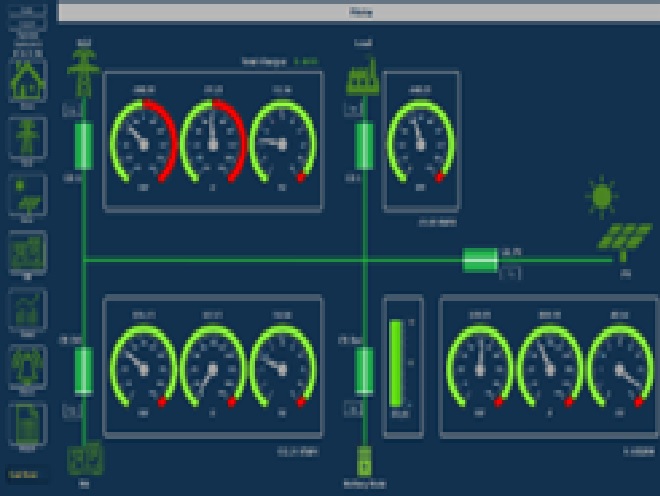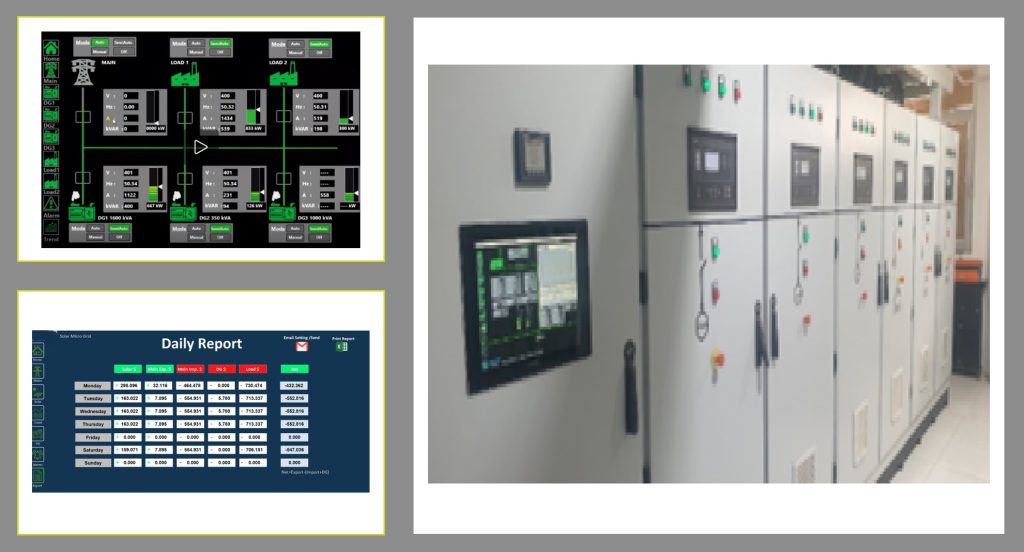
A close friend recently installed a small-scale solar photovoltaic system to power her entire home, and soon after, my neighbor followed suit. Around the same time, an ADISRA partner developed a solar application using ADISRA SmartView, which I will discuss later in this blog.

These events sparked my curiosity about solar energy’s growing role in today’s global energy landscape. Here’s what I discovered: In 2023, utility-scale electricity generation facilities in the United States produced about 4,178 billion kilowatt-hours (kWh), with approximately 21% coming from renewable sources such as solar and wind.[1] Additionally, the U.S. Energy Information Administration reported an estimated 73.62 billion kWh generated from small-scale solar photovoltaic systems, defined as those with less than one megawatt (MW) capacity—similar to those installed by my friend and neighbor. Among end-user sectors, the residential sector accounts for 67% of small-scale solar capacity, followed by the commercial sector at 27% and the industrial sector at 6%[2].
In Europe, the shift towards renewables is even more pronounced, with 44.7% of the EU’s electricity production coming from renewable sources in 2023. In Asia, the share of solar and wind in electricity generation reached nearly the global average, with renewables making up 27% of the region’s electricity mix in 2023[3].
In Europe, the shift towards renewables is even more pronounced, with 44.7% of the EU’s electricity production coming from renewable sources in 2023. In Asia, the share of solar and wind in electricity generation reached nearly the global
average, with renewables making up 27% of the region’s electricity mix in 2023[4].
Europe leads in renewable energy usage due to ambitious policy commitments and regulations that includes the European Union’s Green Deal. This comprehensive set of policy initiatives aims to guide the EU towards a green transition, with the ultimate objective of achieving climate neutrality by 2050[5].
The European Climate Law transforms the goal of achieving climate neutrality by 2050 from a political ambition into a legal obligation for the EU. By enacting this law, the EU and its member states are legally bound to reduce net greenhouse gas emissions to at least 55% by 2030, based on a thorough impact assessment by the Commission. Europeans view climate neutrality as a civic responsibility, believing that reaching this target by 2050 will unlock significant opportunities, including economic growth, new business models and markets, job creation, and technological advancements.
U.S. solar panel manufacturing capacity has quadrupled since the Inflation Reduction Act was passed in August 2022, raising capacity by more than 10 gigawatts to surpass 31 GW nationwide, according to a Q2 report by the Solar Energy Industries Association and Wood Mackenzie.[5] The law has sparked a resurgence in American manufacturing, with new factories across multiple states producing electric vehicles, batteries, solar panels, and other clean energy technologies.
$15.6 billion[6] has been invested in the solar industry since August 2022. So, what trends are driving this continued growth in the solar sector?
Unlocking New Possibilities for Solar Energy

The solar industry is evolving rapidly, driven by innovative technologies, shifting policies, and emerging market trends that will reshape the future of renewable energy as the global commitment to sustainable energy intensifies. Here are some key trends that stood out in my research.
Supply-chain issues
The solar industry heavily depends on suppliers of critical components, including solar modules, cells, wafers, electrolyzers (for green hydrogen), and batteries. China dominates the global market producing eight out of ten solar modules used worldwide. However, the U.S. and India are rapidly building their own solar module manufacturing capacity, spurred by incentives like the Inflation Reduction Act and Production Linked Incentives[7]. In Europe, the European Commission’s Net-Zero Industry Act aims to supply at least 40% of the EU’s demand for net-zero technologies through domestic manufacturing by 2030. Meanwhile, Indonesia is leveraging its vast nickel reserves to develop a domestic battery production capacity of 140 GWh by 2030.
The demand for SCADA/HMI software is expected to grow substantially as global initiatives to expand manufacturing capacity for renewable energy technologies intensify. The swift increase in solar module production in the U.S. and India, combined with the EU’s focus on local manufacturing to meet net-zero targets, will necessitate advanced monitoring and control systems to enhance operational efficiency. Similarly, Indonesia’s ambitious battery production goals emphasize the need for robust SCADA/HMI solutions to oversee complex processes and enable efficient, real-time data management. These trends highlight a rising dependency on sophisticated SCADA/HMI software to support the rapidly expanding renewable energy and battery production sectors.
Cybersecurity
Cybersecurity is an essential requirement. Infrastructure has increasingly become a target for cybercriminals, and emerging alternatives to traditional power grids often lack established utility protocols and regulations. On July 1, 2024, the Federal Bureau of Investigation (FBI) issued a Private Industry Notification (PIN) warning that malicious cyber actors may attempt to disrupt power generation operations, steal intellectual property, or hold critical information for ransom (source: FBI Warning – https://s3.documentcloud.org/documents/24788637/fbiwarning.pdf).
The FBI notice highlighted solar inverters—devices that convert direct current (DC) from solar panels into alternating current (AC) electricity—as vulnerable points in solar operational technology software and hardware. Hackers could exploit these vulnerabilities to manipulate power output or cause energy systems to overheat, posing significant operational risks.
Robust cybersecurity measures are becoming increasingly urgent as solar systems become more interconnected. The FBI advises companies to regularly monitor their networks for suspicious activity and report any signs of cyber threats or unauthorized access to law enforcement.
While traditional power sources have established security protocols that have been rigorously tested over time, newer renewable technologies lack the same level of resiliency and regulatory oversight. SCADA/HMI software can help bridge this gap by providing enhanced security features such as secure communication protocols, user authentication, and data encryption, safeguarding solar assets against cyber threats that could disrupt operations and compromise system integrity. Security must be adaptable at the user level, allowing specific task privileges to be granted or restricted as needed.
Digital Transformation and Artificial Intelligence
Solar energy companies are increasingly automating their business and operational processes by integrating SCADA and HMI software alongside rule-based expert systems to enhance efficiency, reliability, and safety to remain competitive and resilient. Analytical artificial intelligence (AI) technologies, including machine learning, are becoming crucial as companies digitize their solar operations with applications spanning end-to-end, from back-office management and cybersecurity to field operations and solar farm optimization.
The combination of AI, SCADA, and rule-based expert systems offers both challenges and opportunities specific to the solar industry. As solar power generation and storage systems become more interconnected, the rising demand for energy to power data centers and other digital infrastructures puts pressure on the grid. AI-powered hardware, SCADA software, and expert systems can optimize the performance of solar assets, ensuring efficient energy production, distribution, and management across the solar value chain, thereby enhancing the sustainability and reliability of solar energy.
Numerous projects have highlighted the use of real-time rule-based expert systems designed to monitor performance and diagnose issues within solar systems. These expert systems collect data from sensors that track solar system performance, analyze abnormal measurements, and conduct fault diagnostics. Additionally, they compare actual measurements against expected performance to identify potential faults. Rule-based expert systems are also employed for predictive maintenance of solar farms and panels, helping to prevent failures and maximize energy output.
Grid Integration
The integration of solar power into the electrical grid involves multiple stages—generation, transmission, and distribution—each requiring precise control and monitoring to maintain grid stability and efficiency. At the generation stage, solar power plants convert sunlight into electricity, producing variable outputs depending on weather conditions and time of day. SCADA (Supervisory Control and Data Acquisition) software plays a crucial role in managing these variables by providing real-time data on power generation, environmental conditions, and equipment status. Through advanced monitoring and control, SCADA systems can adjust the output of solar inverters, optimize energy capture, and even initiate predictive maintenance actions to minimize downtime, ensuring a consistent energy supply.
During transmission, the electricity generated from solar farms must be transported efficiently over long distances to reach distribution networks and, ultimately, end-users. SCADA software facilitates this by managing the flow of electricity, monitoring voltage levels, and detecting anomalies that could disrupt transmission. For instance, SCADA systems can identify line losses or voltage drops and automatically trigger corrective actions, such as adjusting reactive power compensation or rerouting power flows to maintain grid stability. The software’s ability to coordinate multiple generation sources, including solar, alongside other renewable and conventional energy sources enhances the overall reliability of the transmission network.
At the distribution level, integrating solar energy into local grids poses challenges, such as voltage fluctuations and reverse power flows. SCADA software addresses these challenges by providing utilities with precise control over distributed energy resources, including rooftop solar installations and community solar projects. It allows operators to monitor grid conditions, balance supply and demand in real-time, and manage energy storage systems that can smooth out intermittent solar generation. By utilizing SCADA, distribution operators can maintain optimal voltage levels, prevent overloads, and ensure that solar energy is efficiently utilized and dispatched to meet consumer demand. This holistic approach to grid integration, supported by SCADA technology, enhances the performance and resilience of the entire power system as solar adoption continues to grow.
Enhancing Solar Control: Royalstar Enerji Sistem Adopts ADISRA SmartView for Next-Gen SCADA Solutions

Royalstar Enerji Sistem (RSE), a prominent provider of power solutions in Turkey, Iraq, and Germany, offers comprehensive solutions in the solar energy sector. It is focused on providing advanced technology for solar generation, particularly in hybrid PV-diesel systems and large-scale solar applications, optimizing solar energy production and ensuring seamless integration with the grid.
RSE solar applications utilize ADISRA SmartView to enhance monitoring, control, and optimization of solar power operations. These systems collect data from solar panels and inverters, allowing real-time adjustments to improve efficiency and reliability. This approach is vital for managing the variable nature of solar energy, ensuring consistent power generation, and preventing system faults. Royalstar’s solar solutions are designed to support residential and industrial projects, emphasizing integrating renewable energy into the broader energy grid to meet growing power demands efficiently. An in-depth case study on Royalstar Enerji Sistem (RSE) use of ADISRA SmartView will be available soon.

The accelerated adoption of solar energy will be driven by technological advancements, regulatory support, and global investment, thereby solidifying solar’s crucial role in the sustainable energy’s future. From small-scale residential installations to large utility projects, solar power is reshaping the energy landscape offering cleaner alternatives to traditional energy sources. The industry’s expansion presents opportunities and challenges, particularly in supply chain management, cybersecurity, and grid integration. The solar sector is better equipped to optimize operations, enhance security, and improve efficiency with innovative solutions like HMI/SCADA systems and AI-driven technologies.
As governments, industries, and individuals prioritize sustainability, solar energy’s influence will grow stronger, pushing the boundaries of what’s possible. The recent surge in U.S. manufacturing capacity, alongside significant investments in solar technology, points to a future where solar energy plays a central role in achieving climate goals and driving economic growth. As we look ahead, embracing these trends will be important to unlocking new possibilities for solar energy, ultimately leading us toward a cleaner, more resilient future.
[1] U.S. Energy Information Administration (https://www.eia.gov/tools/faqs/faq.php?id=427&t=3)
[2] https://www.eia.gov/tools/faqs/faq.php?id=427&t=3
[3] https://ember-climate.org/countries-and-regions/regions/asia/
[4] https://ec.europa.eu/eurostat/web/products-eurostat-news/w/ddn-20240627-1#:~:text=Renewables%20made%20up%2044.7%25%20of,of%2012.4%25%20compared%20with%202022.
[5] https://www.manufacturingdive.com/news/us-solar-panel-manufacturing-capacity-q2-tariff-impact/727262/?utm_source=Sailthru&utm_medium=email&utm_campaign=Issue:%202024-09-18%20Manufacturing%20Dive%20%5Bissue:65976%5D&utm_term=Manufacturing%20Dive
[6] https://www.manufacturingdive.com/news/inflation-reduction-act-tracker-clean-energy-manufacturing/715116/
[7] In India, Production Linked Incentives (PLI) is a government initiative to boost domestic manufacturing across various sectors, including the solar industry. The PLI scheme provides financial incentives to companies that increase their production capacity and output in India, focusing on high-efficiency solar modules and cells.
